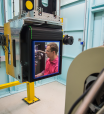
Showing 401 - 420 of 569 results
Fingermark forensics
Most fingermark research has largely focussed on the organic material in residues. Consequently, a gap in fundamental knowledge exists when it comes to inorganic components such as metals.
Understanding how ventilation might impact blood flow in ventilated preterm babies
Hudson Institute of Medical Research and Monash University researchers used synchrotron X-rays produce powerful visualisation of video of changes to blood flow to brain during ventilation in large preterm clinical models.
Reducing, reusing and recycling mining waste
Two approaches use existing low cost and low energy technologies to reuse stockpiled waste from mining operations - capturing carbon dioxide in the form of valuable carbonate minerals.
Insights on service life of industrial components
Electron and X-ray diffraction techniques provide insights into material damage under stress-strain conditions.
FAQs - Macromolecular Crystallography
Frequently Asked Questions on the Macromolecular Crystallography beamlines (MX1 and MX2)
ACNS Finalists for ANSTO Awards in Nuclear Science and Technology
Two international agreements signed
Historic memorandums of understanding on the peaceful use of nuclear with Thailand and Canada.
Blueprint for future drugs
Structure of protein involved in immune response pair revealed.

Role at ANSTO
Research finds possible key to long term COVID-19 symptoms
Researchers from La Trobe University have used the Australian Synchrotron to help identify a key mechanism in how SARS-CoV-2 damages lung tissue.
First light achieved for new micro-computed tomography beamline under Project BRIGHT
Project Bright, the construction of eight new beamlines at ANSTO’s Australian Synchrotron has reached a milestone by achieving ‘First Light’ for the new micro-computed tomography (MCT) beamline in late NovembeR.
Sika operation and research agreement renewed
Agreement extends Taiwan’s National Synchrotron Radiation Research Center’s operation of neutron scattering instrument at ANSTO

High Performance Macromolecular Crystallography Beamline (MX3)
The High Performance Macromolecular Crystallography beamline will enable the study of very small (sub-5 micrometre) or weakly diffracting crystals, providing a state-of-the-art high-throughput facility for researchers. MX3 will be able to study the structures of large proteins and protein complexes for virology, drug design and industrial applications via goniometer mounted crystals, in-tray screening, or via serial crystallography methods.
Appointment of new ANSTO CEO
The Chair of ANSTO, The Hon Dr Annabelle Bennett, AC SC, announced today that Mr Shaun Jenkinson has been appointed Chief Executive Officer of ANSTO following a global search for the position.
Shining a light on brain cancer
Micro radiation therapy being developed by UOW in association with the Australian Synchrotron.
Ultra-thin lithium strips show great promise as anode material for enhanced lithium ion batteries
Chinese researchers have eveloped a novel strategy for the scalable production of high-performance, thin, and free-standing lithium anodes for lithium-ion batteries with enhanced cycling stability and electrochemical properties.
ANSTO proudly participates in a new ARC Centre of Excellence for Indigenous and Environmental Histories and Futures
ANSTO is participating in a new Australian Research Council (ARC) Centre of Excellence for Indigenous and Environmental Histories and Futures (CIEHF) to be headquartered at James Cook University (JCU) that aims to bring Indigenous and environmental histories to the forefront of land and sea management.

Kathleen manages the quality and document management systems, and oversees procedures for inspection, testing, and calibration of equipment and systems, to support the accelerator operations and beam lines.
Dr. Qinfen Gu leads the Powder Diffraction beamline team at the Australian Synchrotron, ANSTO, and serves as an Honorary Principal Fellow in the Department of Chemical Engineering at the University of Melbourne.